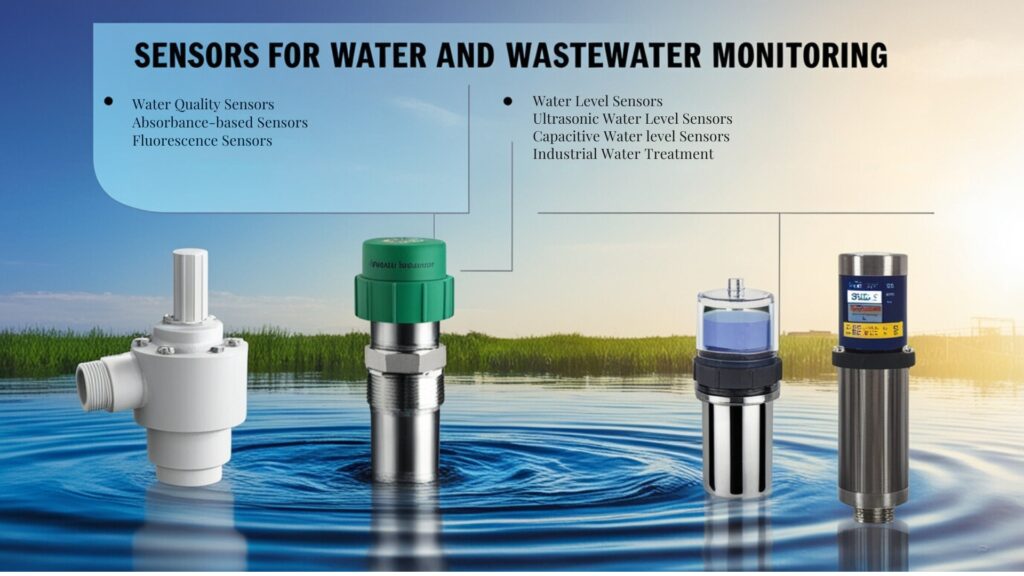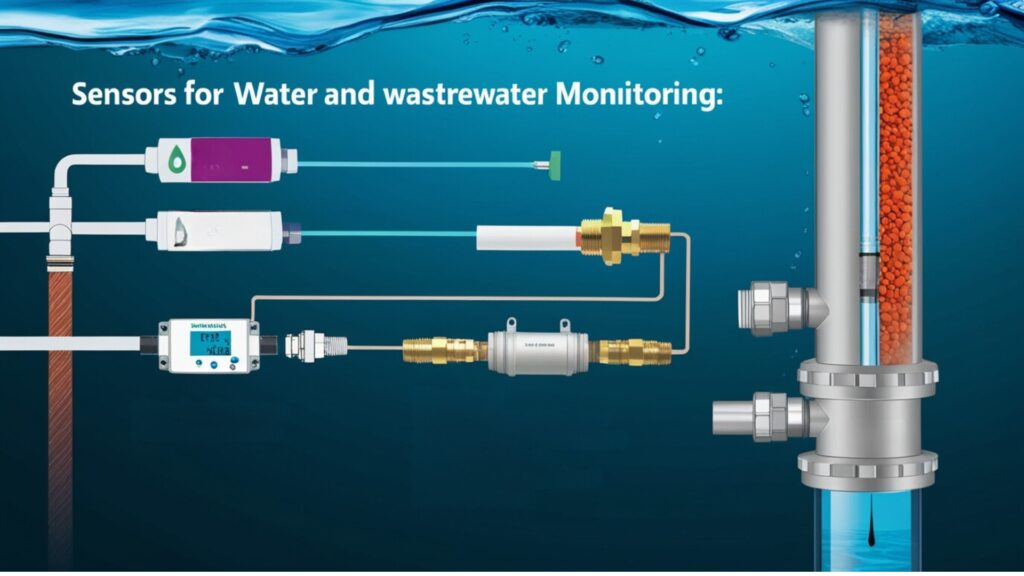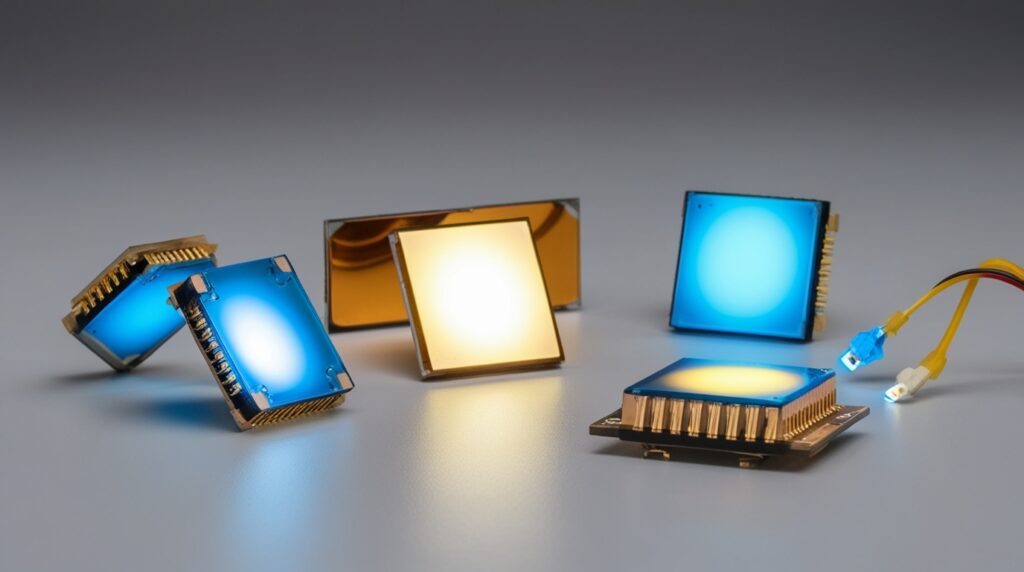
Introduction
Sensors for Water and Wastewater Monitoring are essential technological tools that facilitate the real-time assessment of water quality and levels across various applications, including municipal, industrial, and environmental contexts. By measuring parameters such as pH, turbidity, and chemical composition, these sensors help ensure safe drinking water, effective wastewater treatment, and compliance with environmental regulations.
Their significance is underscored by the global challenges of water scarcity and pollution, which demand innovative solutions for sustainable water management and conservation practices. The monitoring landscape encompasses a diverse array of sensor types, including water quality sensors (such as absorbance-based and fluorescence sensors), water level sensors (like ultrasonic and radar sensors), and integrated sensor nodes that streamline data collection and transmission.
Each type is designed to meet specific operational requirements and environmental conditions, thus enhancing the accuracy and efficiency of water monitoring systems. The integration of digital technologies, including the Internet of Things (IoT) and wireless sensor networks, further amplifies the capabilities of these systems, enabling remote monitoring and advanced data analytics. Despite their advantages, the deployment of sensors in water monitoring faces notable challenges, including environmental influences on sensor performance, data management complexities, and calibration issues that can lead to inaccuracies.
Furthermore, the financial implications of routine maintenance and the need for standardized protocols add layers of complexity to sensor implementation and operation. Addressing these challenges is critical for maximizing the effectiveness of water and wastewater monitoring technologies and ensuring their reliability in safeguarding public health and the environment. As the field evolves, future trends are set to focus on enhancing sensor technologies and integrating them with advanced digital frameworks.
Innovations in design and functionality aim to lower barriers to adoption, while collaborative efforts among stakeholders are essential for fostering an ecosystem conducive to water resource innovation. This ongoing evolution is crucial for achieving resilient water management systems capable of meeting the demands of an increasingly resource-constrained world.
Types of Sensors
Water and wastewater monitoring employs a variety of sensors, each designed to meet specific needs across different applications. These sensors can be categorized based on their function and the physical principles they utilize for measuring various water quality parameters.
1. Water Quality Sensors
1.1 Absorbance-based Sensors
Absorbance-based sensors, including Ultraviolet-Visible-Infrared (UV-VIS-IR) sensors, are effective for monitoring a broad range of physiochemical variables such as nitrate, dissolved organic carbon, and turbidity. These sensors, while accurate under optimal conditions, may face challenges in dynamic environments due to ambient temperature and turbidity effects. Scattering-based turbidity sensors can enhance the accuracy of fluorescence and absorbance measurements by providing detailed insights into sediment transport and improving the signal-to-noise ratio of existing pollutant detection.
1.2 Fluorescence Sensors
Fluorescence sensors offer another method for water quality assessment. Recent advances in micro-sensing technologies, such as mini-spectrometers and light-emitting diodes (LEDs), enable in-situ full-spectrum analysis, including excitation-emission matrices. This capability helps in understanding interferants and improving detection accuracies for both known and emerging contaminants.
2. Water Level Sensors
Water level sensors are critical for maintaining efficient water use and preventing shortages or waste.
2.1 Ultrasonic Water Level Sensors
These sensors utilize high-frequency sound waves to determine the distance to the water surface, making them suitable for large tanks and bodies of water where levels fluctuate rapidly. They provide reliable and accurate measurements, making them widely used in various applications.
2.2 Capacitive Water Level Sensors
Capacitive sensors measure water levels using electrical capacitance. Known for their high accuracy and real-time readings, they are particularly useful in harsh environments exposed to extreme temperatures or chemicals.
2.3 Optical Water Level Sensors
These sensors are commonly used in drinking water systems to monitor levels in tanks and reservoirs, ensuring a constant supply of clean drinking water. They can also be applied in industrial settings to manage water levels effectively.
2.4 Radar Level Sensors
Radar sensors emit microwave signals toward the water surface and calculate water levels based on the time taken for the signals to return. They are ideal for precise measurements in challenging environments, including wastewater tanks and areas with hazardous conditions.
2.5 Non-Contact Ultrasonic Level Sensors
Non-contact ultrasonic sensors operate by emitting ultrasonic pulses into the air, measuring the time taken for the pulses to return from the water surface. They are suitable for applications where contact with the liquid is not feasible, such as reservoirs and rivers.
3. Integrated Sensor Nodes
Integrated sensor nodes collect and preprocess data from various electrodes before transmitting it to a central unit, forming the backbone of Water Quality Monitoring Systems (WQMS). These nodes typically include commercial electrodes, a microcontroller, and a communication module, such as Zigbee, to facilitate data transmission.
4. Point Level Measurement Sensors
Point level measurement sensors, such as float switches and probes, are designed to indicate when the water level reaches a predetermined threshold. These sensors serve as alarms to prevent overfilling or depletion, providing a straightforward and reliable solution for basic level detection. Through these various sensor types and technologies, the water and wastewater industries can effectively monitor and manage water quality and levels, contributing to environmental sustainability and resource conservation.

Applications of Sensors For Water and Wastewater Monitoring
Water Quality Monitoring Systems
Advanced water quality monitoring systems leverage wireless sensor network technology to facilitate real-time data collection and analysis in large aquatic areas. Such systems are crucial for managing water resources effectively and ensuring compliance with environmental standards. The design of these systems includes features for data collection and storage, dissemination through visualizations, power management for extended operational periods, and maintenance interfaces for system administrators.
Smartphone Applications
To enhance user interaction and data accessibility, applications like the “Water Testing Suite” have been developed. This Android-based application is designed for sensor data acquisition, calibration, and cloud-based data storage. It allows users to select various measurement types, such as pH levels, temperature, and specific contaminant analyses, thereby streamlining the monitoring process.
Edge Computing in Utilities
The integration of edge computing within water management systems significantly reduces operational costs and enhances data processing efficiency. By embedding intelligence at the data collection points, utilities can implement real-time data analysis and automated processes, facilitating proactive maintenance. This technology not only helps identify infrastructure risks early but also enhances overall operational efficiency by minimizing the need for manual inspections.
Management Benefits
The adoption of modern sensor technologies in water utilities offers multiple management benefits, including optimized infrastructure maintenance and enhanced worker safety. With real-time data insights, utility teams can manage extensive networks more effectively, reducing the physical presence required for infrastructure checks. Automated alerts for potential issues allow for timely interventions, thus maintaining service quality and reducing operational disruptions.
Wastewater Treatment Applications
Wastewater treatment plants play a critical role in urban infrastructure by treating polluted water to prevent environmental degradation and public health hazards. These facilities must adhere to strict quality and efficiency standards. Effective monitoring systems ensure compliance with regulations and operational efficiency, as they allow for real-time adjustments in treatment processes based on current water chemistry.
Tertiary Treatment Processes
In wastewater treatment, tertiary treatment processes further disinfect water and remove residual pollutants, meeting stringent discharge limits to protect aquatic ecosystems. Advanced monitoring systems are essential for achieving these high treatment goals and for ensuring compliance with environmental regulations regarding total phosphorus and nitrogen levels in various water bodies.
Industrial Water Treatment
Industrial water treatment systems benefit from continuous monitoring and automation, allowing for effective management of chemical feed rates and compliance with environmental standards. The dynamic nature of industrial water chemistry necessitates regular adjustments, which can be efficiently managed through automated instrumentation. Proper monitoring not only enhances operational quality but also leads to significant water and energy savings.
Smart Water Management Technologies
The implementation of smart water management (SWM) technologies varies across regions, with broader objectives in mind. For instance, Singapore focuses on resource conservation and operational efficiency, while other regions, such as Bengaluru, face challenges in technology adoption due to high costs and narrow objectives. SWM technologies are essential for optimizing water supply operations and encouraging conservation practices. The success of such implementations hinges on a comprehensive understanding of target problems, enabling conditions, and desired outcomes.
Technologies Used in Sensors For Water and Wastewater Monitoring
Digital Technologies in Water Management
Digital technologies play a crucial role in urban water management, enhancing the processes of water supply, demand management, and asset management. Integrated ICT solutions are essential for providing comprehensive strategies in these areas, particularly in managing public perception of recycled water usage. The adoption of digital technologies encompasses various systems, such as SCADA, which facilitate real-time monitoring and analysis of water systems, helping to address challenges in efficiency that often arise during implementation.
Internet of Things (IoT)
The integration of IoT devices marks a significant advancement in water monitoring systems. These devices facilitate remote, real-time insights into water quality, level, and usage, allowing for prompt responses to anomalies. Smart water meters, leak detection systems, and flood monitoring solutions are among the tools that harness the capabilities of IoT, promoting more informed decision-making regarding water management and conservation. IoT systems are particularly beneficial in both urban and agricultural settings, enabling efficient monitoring of water resources even in remote locations.
Wireless Sensor Networks (WSN)
Wireless Sensor Networks (WSNs) have emerged as an effective method for monitoring both physical and chemical characteristics of water. These systems are designed to provide near real-time data acquisition while reducing manpower requirements. Sensor nodes collect data from various sensors, processing and transmitting this information to central units for analysis. WSNs can be deployed in challenging environments, including aquatic areas, making them vital for comprehensive environmental monitoring.
Smart Water Level Monitoring Systems
The shift towards smart water level monitoring systems, facilitated by IoT technology, offers a transformative approach to managing water resources. These systems utilize a network of interconnected sensors to provide immediate insights into water levels, quality, and flow rates, which enhances overall system management and quickens issue resolution, such as leak detection. In an era marked by growing water scarcity, the implementation of these smart systems is critical for promoting effective water regulation and conservation.
Challenges in Adoption
Despite the advantages offered by these technologies, their effectiveness can be hindered by challenges related to adoption and implementation. The decision-making phase for utilizing specific technologies often outlines the desired outcomes, which can vary significantly based on local conditions and regulatory environments. Furthermore, while digital technologies are designed to operate efficiently, their performance can be compromised if not appropriately integrated into existing systems or if there are gaps in data processing and communication infrastructure.
Challenges and Limitations in Sensors For Water and Wastewater Monitoring
Environmental Influences
Environmental factors can also impact sensor performance. Variability in the composition of water samples may lead to significant errors in measurement, particularly for parameters like Biochemical Oxygen Demand (BOD), Chemical Oxygen Demand (COD), or Total Organic Carbon (TOC). The influence of various organic substances within samples complicates calibration efforts and can result in inaccuracies if the dominant molecules do not absorb in the necessary wavelength ranges.
Data Management and Legal Considerations
One of the primary challenges in the field of water and wastewater monitoring is effective data management. Issues related to public and legal perspectives, along with the need for repeatability and transparency in research, must be addressed to advance intelligent applications in this area.
Calibration and Standardization
Calibration of sensors is critical for ensuring accurate measurements. Each sensor operates based on specific algorithms that convert raw signals into concentration values, which require precise calibration. The calibration process varies according to the type of sensor and application, necessitating different algorithms for municipal wastewater, drinking water, and industrial wastewater. However, there are no universal standards for pre-data and post-data calibration, leading to potential variability and inaccuracies in results.
Maintenance Costs
Routine maintenance presents another challenge. Many sensors, such as Ion Selective Electrodes, require frequent replacement of membranes, contributing to the overall maintenance costs. Furthermore, understanding the life cycle costs of sensors—including their lifespan and maintenance expenses—is essential for effective resource allocation.
Data Analysis Complexity
The processing of large volumes of data can be daunting without the expertise of data scientists, complicating data analysis across multiple projects. Standardization of data analysis techniques is necessary to improve consistency and reliability in results.
Sensor Stability
Stability is another critical factor in sensor performance. Sensors that require frequent calibration may not be suitable for applications where operators visit the site infrequently. For instance, while conductivity sensors may maintain stability over extended periods, pH or ORP sensors might require more regular adjustments, affecting operational efficiency.
Case Studies in Sensors For Water and Wastewater Monitoring
Continuous Monitoring in Stonyfell, South Australia
A noteworthy case study focuses on the implementation of a permanent continuous monitoring system for a sewage network in the suburb of Stonyfell, South Australia. This system employs ultrasonic water level sensors to detect blockages or chokes within the sewage system. Analysis of 62 data sets collected over one year revealed two significant indicators of growing chokes: irregular peaks and prolonged durations of elevated water levels in sewer maintenance holes. The findings underscore the importance of real-time monitoring in mitigating wastewater overflow incidents, which pose significant risks to both environmental integrity and public health.
Digitalization in Bengaluru and Singapore
In another examination of digital advancements in wastewater management, a comparative analysis between Bengaluru and Singapore illustrates how differing infrastructures impact the digitalization process within water management systems. This analysis emphasizes four critical aspects: identification of target problems, enabling conditions, implementation processes, and expected outcomes post-digitalization. The study suggests that adopting technologies like SCADA systems can enhance operational efficiency, reduce water loss, and increase revenue generation while improving social acceptance of digitalization initiatives.
Automation in Wastewater Treatment Plants
Industry 4.0 presents transformative opportunities for wastewater treatment plants (WWTPs) through enhanced connectivity and operations. By installing sensors and integrating various internal and external data sources, operators can automate processes, allowing algorithms to provide actionable insights and optimize plant performance. This approach is predicted to result in improved operational robustness and cost efficiency, thus revolutionizing the management of wastewater treatment.
Water Quality Monitoring Innovations
The City of Phoenix exemplifies the effective application of innovative technologies in wastewater management, where 97% of treated wastewater is recycled for various uses, including irrigation and cooling for power generation. The use of Kando Pulse devices, which ensure the quality of wastewater before entering treatment plants, is poised to meet upcoming regulatory requirements for sewer monitoring. This proactive approach highlights the potential for integrating advanced sensor technologies to enhance wastewater quality management.
Future Research Directions
Future research endeavors aim to incorporate semi-supervised learning techniques into anomaly detection frameworks for wastewater treatment. By broadening the analysis to include biological faults and exploring diverse sensor types, researchers intend to gain a deeper understanding of the complexities inherent in wastewater treatment processes. The integration of real-world data into experimental designs will further enhance the identification of operational challenges and opportunities within this critical field.
Future Trends
The future of water and wastewater monitoring is poised to be significantly influenced by advancements in sensor technologies and digitalization. Researchers, scientists, and practitioners in environmental science and artificial intelligence (AI) are actively exploring innovative solutions to enhance water sustainability and management practices. A notable trend is the integration of various sensor technologies, such as fluorescence, absorbance, and remote sensing, to improve spatial coverage, particularly in expansive river networks. Future research aims to align sensor networks with statutory monitoring locations to facilitate the development of robust calibration algorithms and proxy models.
Digitalization and Water Demand Management
In urban environments like Singapore, the escalating water demand necessitates substantial digitalization efforts. The city-state is adopting smart water management (SWM) strategies to address future demand scenarios, underscoring the importance of digital solutions in optimizing water resource management. The Smart Cities mission initiated in India also emphasizes the integration of adequate water supply systems, digitalization, and governance as key features for promoting sustainable urban environments.
Innovations in Sensor Technologies
Technological improvements in sensor design and interfaces are expected to lower financial and infrastructural barriers associated with water monitoring. This includes utilizing local materials and resources to create automated water quality monitoring systems (WQMS) that can adapt to specific local needs. The growing market for sensors in water and wastewater treatment is forecasted to exceed $2 billion by 2030, driven by increased adoption at municipal levels.
Collaborative Ecosystems for Innovation
Facilitating innovation in water management will require the establishment of local ecosystems that promote collaboration among stakeholders, including public and private sectors and civil society. Multi-stakeholder platforms can drive the uptake of new technologies and institutional models, thereby enhancing the efficiency of water financing and operational investments. The shift towards a more transparent data-sharing environment is also crucial for measuring success and ensuring accountability in water resource management.


